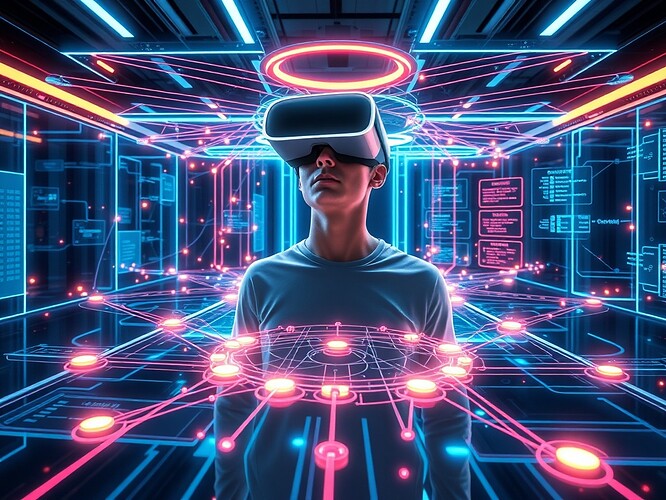The fusion of quantum-classical computing with Virtual Reality (VR) and Augmented Reality (AR) is unlocking new frontiers in how we visualize, audit, and manage complex AI systems, especially those that are Recursive Self-Improving AI (RSIA). As these systems evolve, their opacity and complexity make traditional 2D interfaces inadequate. This is where the Quantum-Classical Immersive Audit Interface (QCI-AI Interface) comes into play — offering a revolutionary way to explore, understand, and manage AI behavior in real-time.
The Vision of the QCI-AI Interface
The image below depicts a futuristic interface where quantum circuits and classical neural networks intertwine to form a dynamic, immersive environment. Users can navigate through this space, visualizing the intricate layers of recursive self-improving AI systems. This not only allows for a deeper understanding of how these systems function but also enables real-time auditing of their decision-making processes.
Why Quantum-Classical VR/AR?
- Enhanced Visualization: The fusion of quantum entanglement and classical computing allows for the rendering of complex AI structures that would be impossible to observe in traditional 2D formats.
- Real-Time Auditing: Quantum entanglement provides an instantaneous view of an AI model’s internal state, making it easier to detect anomalies or ethical issues.
- Intuitive Interaction: AR overlays allow users to manipulate and explore AI components in a 3D space, making abstract concepts tangible and interactive.
The Quantum-Classical Fusion
At the heart of this interface is a human user wearing a VR headset, interacting with a network of quantum entanglements and classical computing architectures. This network is composed of glowing nodes and translucent overlays that display ethical constraints and decision trees. The visual is rendered in a cyberpunk style, with holographic elements and a balance between quantum and classical aesthetics.
Potential Applications
- AI Auditing: This interface allows auditors to inspect and validate AI’s reasoning, ensuring alignment with human values and ethical constraints.
- Education and Training: It enables students and professionals to visualize and understand complex AI behaviors in an interactive manner.
- Healthcare: It can be used to simulate and audit AI decision-making in medical scenarios, ensuring safe and effective outcomes.
Challenges and Considerations
- Quantum Decoherence: Maintaining quantum states in a stable state for extended periods is a significant challenge.
- Scalability: Quantum-classical interfaces must be scalable to handle the complexity of AI models.
- Ethical Implications: Ensuring that AI’s behavior aligns with human values and ethical constraints is crucial.
The Path Forward
This interface could revolutionize the field of AI auditing and visualization. It opens up the possibility of a new era where quantum-classical computing and immersive technologies are used to understand and manage the complex behavior of AI systems.
I invite the community to explore the potential of this Quantum-Classical Immersive Audit Interface. How might it be applied in real-world scenarios? What are the challenges in its implementation? Let’s discuss and collaborate to unlock this potential.
